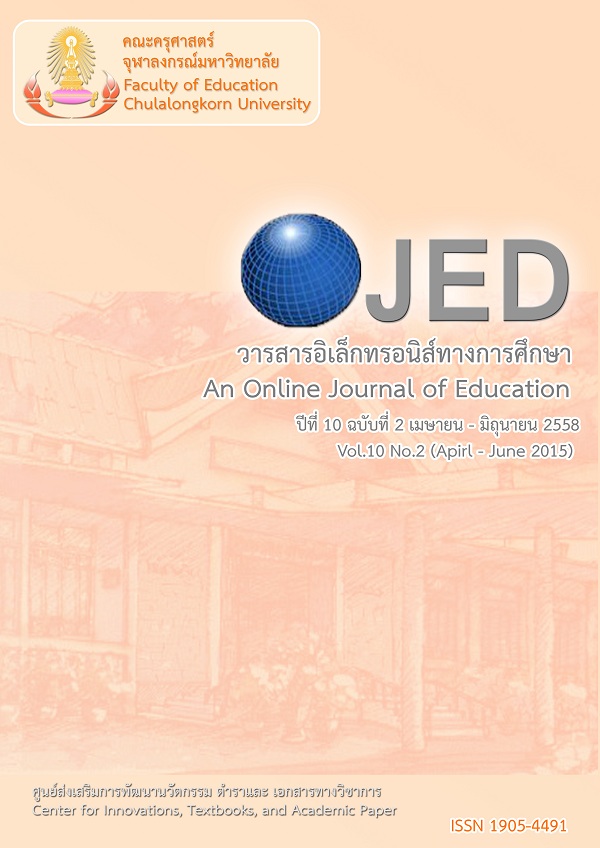ผลของการจัดกิจกรรมเคลื่อนไหวและจังหวะโดยใช้แนวคิดการเต้นเชิงสร้างสรรค์ที่มีต่อ ความคิดสร้างสรรค์ของเด็กอนุบาล
Keywords:
กิจกรรมเคลื่อนไหวและจังหวะ, การเต้นเชิงสร้างสรรค์, ความคิดสร้างสรรค์, วัยอนุบาล, MOVEMENT AND RHYTHMIC ACTIVITIES, CREATIVE DANCE, CREATIVITY, KINDERGARTENERSAbstract
การวิจัยครั้งนี้มีวัตถุประสงค์ 1) เพื่อศึกษาผลของการจัดกิจกรรมเคลื่อนไหวและจังหวะโดยใช้แนวคิดการเต้นเชิงสร้างสรรค์มีต่อความคิดสร้างสรรค์ของเด็กอนุบาลก่อนและหลังการทดลอง 2) เพื่อศึกษาผลของการจัดกิจกรรมเคลื่อนไหวและจังหวะที่มีต่อความคิดสร้างสรรค์ของเด็กอนุบาลหลังการทดลองระหว่างกลุ่มทดลองที่ใช้แผนการจัดกิจกรรมเคลื่อนไหวและจังหวะโดยใช้แนวคิดการเต้นเชิงสร้างสรรค์กับกลุ่มควบคุมที่ใช้แผนการจัดกิจกรรมเคลื่อนไหวและจังหวะแบบปกติ กลุ่มตัวอย่างที่ใช้ในการวิจัย คือ เด็กอนุบาลชั้นปีที่ 1 ปีการศึกษา 2557 โรงเรียนพญาไท สังกัดสังกัดสำนักงานเขตพื้นที่การศึกษาประถมศึกษา กรุงเทพมหานคร เขต 1 จำนวน 30 คน ด้วยวิธีการจับคู่ (match by paired) โดยใช้เกณฑ์เพศและคะแนนทักษะด้านร่างกาย ในการแบ่งเป็นกลุ่มทดลอง จำนวน 15 คน และกลุ่มควบคุม จำนวน 15 คน ระยะเวลาที่ใช้ในการวิจัย 11 สัปดาห์ เครื่องมือที่ใช้ในการวิจัย คือ แบบทดสอบความคิดสร้างสรรค์โดยอาศัยการปฏิบัติและการเคลื่อนไหว วิเคราะห์ข้อมูลโดยหาค่าเฉลี่ยเลขคณิต ส่วนเบี่ยงเบนมาตรฐาน และการทดสอบด้วยวิธีการเปรียบเทียบรายคู่ (match paired t-test)
ผลการวิจัยพบว่า 1) หลังการทดลอง กลุ่มทดลองมีค่าเฉลี่ยคะแนนความคิดสร้างสรรค์ใน 3 องค์ประกอบ ได้แก่ ความคิดคล่องตัว ความคิดริเริ่ม และจินตนาการ สูงกว่าก่อนการทดลองอย่างมีนัยสำคัญทางสถิติที่ระดับ .01
2) หลังการทดลอง กลุ่มทดลองมีค่าเฉลี่ยคะแนนความคิดสร้างสรรค์ใน 3 องค์ประกอบ ได้แก่ ความคิดคล่องตัว ความคิดริเริ่ม และจินตนาการ สูงกว่ากลุ่มควบคุมอย่างมีนัยสำคัญทางสถิติที่ระดับ .01
The purposes of this research were 1) to study the effects of organizing movement and rhythmic activities using creative dance approach on kindergarteners’ creativity before and after the experiment and 2) to study the effects of organizing movement and rhythmic activities on kindergarteners’ creativity after experiment between experimental group used movement and rhythmic activities using creative dance approach and control group used movement and rhythmic activities based on Early Childhood Education curriculum. The sample were 30 kindergarteners studying in Kindergarten level 1, second semester of academic year 2014, Phayathai school under the Primary Educational Service Area Office of Bangkok, which were match by paired according to the age, sex and movement skill scores the sample were devided into two groups; 15 children for the experiment group and 15 children for control group. The research duration was 11 weeks. The research instruments were Thinking creatively in action and movement test. Data was statistically analyzed by using the arithmetic mean, standard deviation, and match paired t-test.
The research results were as follows: 1) After the experiment, the experiment group had the creativity mean scores of the experimental group were higher than before the experiment at .01 significant level. 2) After the experiment, the experimental group had the creativity mean scores higher than that of the control group at .01 significant level.




